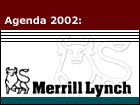
NEW YORK (Money Magazine) - Once upon a time, there was a kid named Stanley. He lived on a subsistence farm outside a tiny town (pop. 900) in rural Alabama. But he was smart and diligent, and he succeeded against steep odds. Stanley's ambition led him to the tony corridors of Wall Street, historically an inhospitable venue for African Americans, and he eventually became head of the most influential brokerage on earth.
There was only one problem: He happened to take charge at the worst moment for financial firms in a generation.
Welcome to the world of Stanley O'Neal, the president and CEO-in-waiting of Merrill Lynch, America's premier brokerage and longtime standard-bearer on Wall Street.
With 16,100 brokers around the globe, $1.3 trillion in retail customer assets and a top position in all major investment banking areas, Merrill Lynch is the quintessential financial leader, a dominant player that even the brashest of competitors can't help but look to for lessons and direction.
And right now, the glare of scrutiny is intense indeed, as O'Neal -- in some ways the most unlikely of Wall Street chieftains -- comes to the helm at a time of unparalleled crisis.
With the stock market coming off two dismal years, the U.S. and global economies in their first simultaneous recession since the 1970s and the repercussions of Sept. 11 hampering everything from consumer confidence to financial recovery, the entire brokerage industry -- from minnows like Ameritrade to leviathans like Morgan Stanley Dean Witter, Charles Schwab and Goldman Sachs -- has been thrown into disarray.
But Merrill's suffering has been particularly acute. Last summer, when investor complaints against advisers picked up as account balances plummeted, Merrill caught the lion's share of the bad press, thanks to a now settled arbitration case that blamed Merrill's former Internet guru Henry Blodget for huge losses. But that was only the beginning.
On the financial front, the firm -- which had posted record quarterly earnings in April 2000 of $1.04 billion -- came full circle, announcing a shocking $1.3 billion loss in the fourth quarter of 2001, including a $1.7 billion restructuring charge. Meanwhile Merrill's stock, once as high as $80 a share, hit a 52-week low of $33.50 on Sept. 21. While it has since recovered to $51, that's still 36 percent off its peak, prompting renewed speculation about whether Merrill will ultimately become merger-bait for another, larger company.
Into this less than auspicious scenario steps the 50-year-old O'Neal, who took over the day-to-day operations of the brokerage last July. Unlike his predecessors at the helm over the past 30 years, he himself has never been a broker. So did that make O'Neal tentative? Did he bide his time and rely on Merrill's long traditions and powerful brand to carry him through the rough spots? Did he equivocate, waiting timidly for a market or economic recovery to revive his firm's fortunes?
Not a chance. Soon after taking over, O'Neal ordered a detailed review of Merrill's entire operations. Then he quickly asserted his authority, acting without reverence for Merrill tradition -- or for the feelings of his titular boss, chairman and CEO David Komansky.
O'Neal slashed or jettisoned international brokerage operations from Canada to South Africa, Australia to Japan -- despite the fact that Komansky had assembled many of these assets, often at great expense, as a key part of his strategy.
"Having determined that these decisions clearly were not right at this point in time," says O'Neal, "the worst thing that one can do...is to stand on ceremony and allow that to persist." O'Neal also made 13 changes among the 22 members of Merrill's executive committee. And he dramatically reduced Merrill's head count. In the past year Merrill has laid off 15,000 employees -- 21 percent of its work force.
O'Neal clearly knows where he wants to take Merrill, and it's someplace very different. While "convergence" has been the prevailing buzzword in financial services in recent years -- as banks, brokerages, insurers and asset managers all scurry to get into one another's business, often through mergers and acquisitions -- O'Neal wants to focus on what Merrill does best rather than trying to be all things to all people.
To a large extent, Merrill's mission is to provide financial advice to affluent Americans. But even Merrill's powerful corps of U.S. brokers has not been immune as O'Neal redefines the company's priorities. He's pushing them to change the nature of customer relationships and target different sorts of clients; he's even tinkering with their sacred compensation structure.
And O'Neal says he's just getting started. He likens his challenge to the one facing Lou Gerstner in 1993 when he took charge of IBM, another American icon. "Lou Gerstner took a couple of years," says O'Neal, "but it worked out pretty well for him." For anyone familiar with Gerstner's scorched-earth approach to overhauling IBM, it's a remarkably telling comment. The implications for Merrill's brokers, customers and competitors are enormous.
Page 2: Read more on Stan O'Neal.
-Additional research by Adrienne Carter

|

